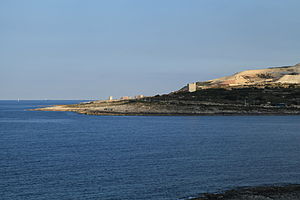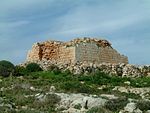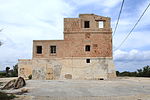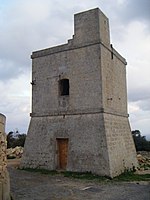
Qawra Tower, also known as Qawra Point Tower or Fra Ben Tower, is a small watchtower in Qawra, limits of St. Paul's Bay, Malta. It was completed in 1638 as the fourth of the Lascaris towers. An artillery battery was built around the tower in 1715. Today, the tower and battery are a restaurant.

Madliena Tower, originally known as Torre della Paulina, is a small watchtower in Madliena, limits of Pembroke, Malta. It was completed in 1658 as the fourth of the De Redin towers. The British built an artillery battery next to the tower in 1908–1909, and the tower and battery remained in use until World War II. Today, the battery no longer exists but the tower is in good condition.

Għajnsielem, meaning "Peaceful Spring", is a municipality on the southeastern coast of the island of Gozo in Malta, including the entire island of Comino. It has a population of 3,200 residents, and is the first Gozitan village that greets the visitor on leaving Mġarr Harbour towards the Gozitan heartland. Its name originated from the water spring, around which in 1700, Grandmaster Perellos built an arcade containing public wash basins and fresh water spouts. Attractions include Lourdes Chapel with its sharp steeple and underlying niche of Our Lady of Lourdes, Fort Chambray and the towering of Ghajnsielem Parish Church.

Saint Agatha's Tower, also known as the Red Tower, Mellieħa Tower or Fort Saint Agatha, is a large bastioned watchtower in Mellieħa, Malta. It was built between 1647 and 1649, as the sixth of the Lascaris towers. The tower's design is completely different from the rest of the Lascaris towers, but it is similar to the earlier Wignacourt towers. St. Agatha's Tower was the last large bastioned tower to be built in Malta.
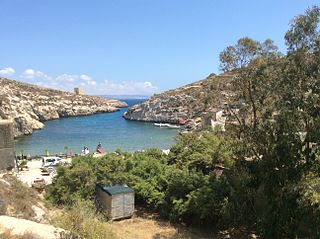
Mġarr ix-Xini, is a bay close to Għajnsielem (southwest), Xewkija and Sannat (southeast) on the Maltese island of Gozo. It lies in a gorge to the west of Mġarr Harbour, accessible mainly from the nearest village of Xewkija as well from Sannat.
This page list topics related to Malta.

The coastline of Malta consists of bays, sandy beaches, creeks, harbours, small villages, cities, cliffs, valleys, and other interesting sites. Here, there is a list of these different natural features that are found around the coast of Malta.
The Lascaris Towers are a series of mostly small coastal watchtowers built in Malta by the Order of Saint John between 1637 and 1652. The first seven towers were built around the coast of mainland Malta between 1637 and 1638. Between 1647 and 1652, a large tower was also built on mainland Malta, and two smaller ones were built on Gozo.
The Wignacourt towers are a series of large coastal watchtowers built in Malta by the Order of Saint John between 1610 and 1620. A total of six towers of this type were constructed, four of which survive.

Għajn Ħadid Tower, originally known as Torre di Salomone and known by locals as Xagħra Tower, is a ruined watchtower in Selmun, limits of Mellieħa, Malta. It was built in 1658 as the first of the De Redin towers. The tower has been in ruins since its upper floor collapsed in an earthquake in 1856.

Din l-Art Ħelwa is a non-governmental and non-profit, voluntary organisation founded in 1965 by Maltese Judge Maurice Caruana Curran to safeguard Malta's cultural heritage and natural environment. Since its foundation, Din l-Art Ħelwa has restored numerous cultural sites of historic and environmental importance and currently has the guardianship of a number of them. Many of the sites are open to visitors and for events, all thanks to an army of dedicated volunteers. The organisation promotes the preservation and protection of historic buildings and monuments, the character of Malta's towns and villages, and places of natural beauty. It is very active in campaigning against proposed construction which infringes planning laws or policies, and regularly objects to planning applications, taking legal action to halt development in some cases. The NGO stimulates the enforcement of existing laws and the enactment of new ones for the protection of Malta's natural and built heritage.

Wardija Tower, originally known as Torre della Guardia di Giorno and also known as Bubaqra Tower, is a small watchtower in the limits of Żurrieq, Malta. It was completed in June 1659 as the last of the thirteen De Redin towers.
Post codes in Malta are seven-character strings that form part of a postal address in Malta. Post codes were first introduced in 1991 by the mail operator MaltaPost. Like those in the United Kingdom and Canada, they are alphanumeric.
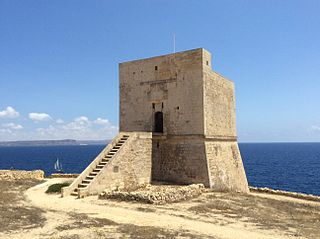
Mġarr ix-Xini Tower is the largest of the coastal watchtowers that the Knights of Malta erected on the island of Gozo. It watches over the entrance to the bay of Mġarr ix-Xini, limits of Għajnsielem, which lies on Gozo's south-west coast.

Delimara Tower, originally known as Torre della Limara, was a small watchtower on the Delimara Peninsula, in the limits of Marsaxlokk, Malta. It was built in 1659 as the tenth De Redin tower, and an artillery battery was later built nearby in 1793. Both the tower and the battery have been demolished.
Xrobb l-Għaġin Tower, originally known as Torre di Siuarep, is a ruined watchtower in Xrobb l-Għaġin, limits of Marsaxlokk, Malta. It was built in 1659 as the eighth of the De Redin towers. An entrenchment with two redans was built around it in 1761. The tower is now largely destroyed since it was built of globigerina limestone which is prone to erosion. The remains of the tower's scarped base, as well as the general outline of the entrenchment, can still be seen.

Triq il-Wiesgħa Tower, originally known as Torre della Giddida and also called Mwejġel Tower, is a small watchtower near Żabbar, Malta. It was built in 1659 as the ninth of the De Redin towers. The tower suffered extensive damage in the 20th century, with parts of the structure being demolished, but it was restored between 2008 and 2009 and it is now in good condition.

The fortifications of Malta consist of a number of walled cities, citadels, forts, towers, batteries, redoubts, entrenchments and pillboxes. The fortifications were built over hundreds of years, from around 1450 BC to the mid-20th century, and they are a result of the Maltese islands' strategic position and natural harbours, which have made them very desirable for various powers.

Aħrax Tower, originally known as Torre di Lacras, and also known as Armier Tower, Ta' Ħoslien Tower or the White Tower, is a small watchtower overlooking Armier Bay in the limits of Mellieħa, Malta. It was built in 1658 as the sixth of the De Redin towers. An artillery battery was built around it in 1715. Today, the tower and battery are intact. After receiving 3 years of restoration work the tower was reopened to the public on the 9th of June 2021.
